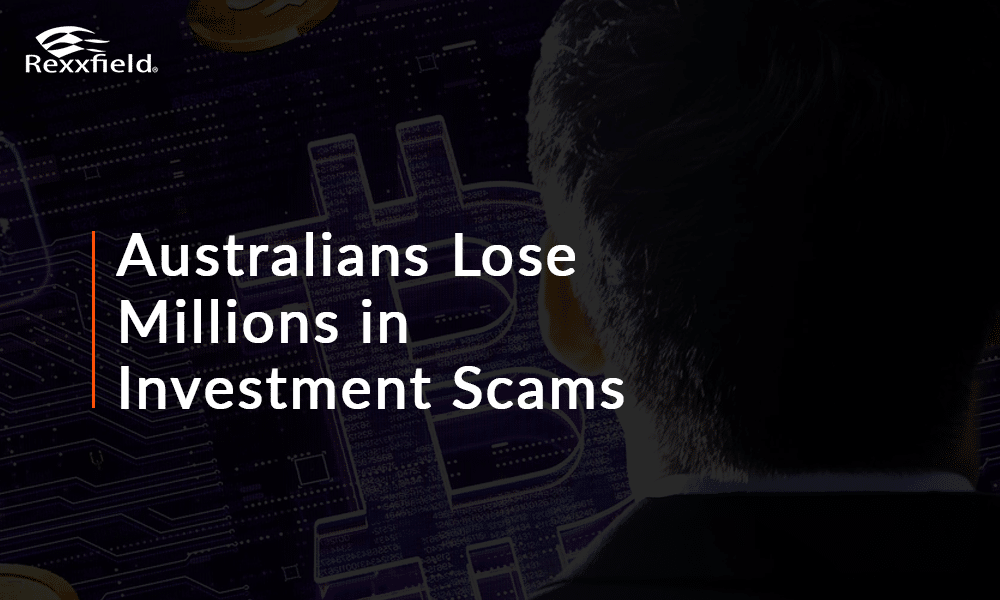Crypto Nightmare In Australia
A Guardian Australia investigation uncovered that numerous investors in Australia have suffered significant financial losses due to crypto investment scams, such as HyperFund and HyperVerse, despite warnings from financial authorities abroad labeling them as potential “scams” and “suspected pyramid schemes.” Thousands of dollars have vanished, proving that these dodgy schemes have managed to slip past the radar of regulators in Australia.
Sam Lee, who was once known as “the crown prince of bitcoin” in Australia, and Zijing “Ryan” Xu, who has positioned himself as “one of China’s four bitcoin kings”, are among the founders of the defunct Australian bitcoin company Blockchain Global.
In 2021, Blockchain Global found itself in financial trouble and owes creditors a whopping $58m. In a twist of events, the liquidator for the company took matters into his own hands and referred Lee and Xu to the Australian Securities and Investments Commission for potentially breaking the law. Despite the liquidator’s efforts, he has been unable to fully investigate Lee and Xu as they have moved overseas, leaving him unable to serve them legal documents. ASIC, on the other hand, has chosen not to take any further action at this time.
But that’s not all – it turns out that Lee and Xu have been promoting various cryptocurrency investment schemes since 2018, many of which have failed, leaving investors without access to their funds.
The floundering of these plans, causing countless individuals worldwide to lose their deposits, has sparked worry in Australia about the regulator’s responsibility in alerting investors to risky, unregulated investment schemes and potential scams.
Chris Berg, the head honcho of RMIT’s Blockchain Innovation Hub, and totally not involved in Lee and Xu’s blockchain shenanigans, mentioned that there has been a crazy amount of crypto schemes popping up during the pandemic, and the regulators just don’t have the smarts to keep up. “There’s a big ol’ gap in our regulators’ crypto know-how and it’s causing all sorts of issues when it comes to figuring out how to regulate these schemes properly and sniffing out potential scams,” he explained to Guardian Australia.
Global warnings
The various investment platforms of Lee and Xu’s, together with those operating under the HyperTech group that was designed in 2020, gave red signals from financial regulators in most countries. Countries include Hungary, New Zealand, Germany, United Kingdom and Canada. HyperCapital was run by Lee and Xu established in 2018, just before the establishment of HyperTech.
In August 2022, the Hungarian central bank issued a public statement advising consumers to practice caution prior to investing in the HyperVerse and HyperFund schemes, drawing parallels between the underlying structure of these schemes and a “suspected pyramid scheme,” noting that there is an absence of genuine economic activity and the system’s only source of income stems from the payments made by new participants.
The warning went on to say that investors have a pretty good chance of saying goodbye to some or all of their hard-earned cash for good.
Not a single word was said by ASIC regarding the sneaky schemes of HyperTech group to this day. ASIC however acknowledges sharing general information about dangers of dealing with unlicensed groups selling unregulated items on their website. According to ASIC, when it comes to warnings, different regulators in different areas will take action based on the evidence of activities in that area in accordance with the law in place.
In September 2021, the Financial Market Authority of New Zealand sounded the alarm with a public warning, expressing their serious apprehension that HyperFund could potentially be running a deceptive scheme.
The Multi Level Marketing (MLM) that Hyperfund was running, touting itself as a source of effortless investment prospects even though they lack the proper registration and licensing to offer financial services or products in New Zealand. Lets keep HyperTech project aside for a sec, Lee has been linked to the endorsement of several promising investment opportunities like We Are All Satoshi , VAV, VidiLook, V.E.N.D, and StableDao. We Are All Satoshi and StableDao are still up and running and in August, Lee was pushing for the comeback of the Hyper brand with the Hyper Ascension program.
Apart from the HyperTech projects, Lee has also been linked to the endorsement of several seemingly promising investment opportunities such as StableDao, VidiLook, VAV, V.E.N.D, and We Are All Satoshi. StableDao and We Are All Satoshi are still up and running, and just this August, Lee was pushing for a comeback of the Hyper brand with the Hyper Ascension program. It’s unclear if Xu has any ties to these other investment ventures that Lee is backing.
In September, California’s financial watchdog slammed the brakes on Lee’s We Are All Satoshi investment platform, accusing it of running a shady pyramid and Ponzi scheme and ordering them to cease and desist immediately.
The commissioner claimed that the We Are All Satoshi scheme “does not offer or claim to offer any tangible goods and has no visible way of making money aside from the funds it gets from investors.”
Lee was labeled as the “mastermind, head honcho, and big cheese” of We Are All Satoshi and accused of honing in on investors in the state, breaking a bunch of rules from the state’s corporations code, and being told to halt operations “until all the legal boxes were ticked” under California law. Xu, on the other hand, was left out of the mix and there’s no hint of him doing anything shady in this department.
In 2021, Lee decided to kick it in Dubai while Xu is out there living his mysterious life.
‘Offer me 2%’
At We Are All Satoshi, it seems like they’re following in the footsteps of past investment schemes, offering subscription packages to “members” and tempting them with the allure of big, daily profits.
HyperVerse’s argument was that it operates on a membership basis, hence it doesn’t fall under the jurisdiction of financial regulators as an investment product. The financial authorities don’t acknowledge this argument, especially in the areas where hyperVerse was heavily involved. Stakeholders were encouraged to invest with Cryptocurrency to get subscription packages. These rewards are earned in the form of HYPER UNITS at a 0.5% rate per day. That’s not all, the classic pyramid scheme participants were motivated to enlist new members. Like a tree, they were taught how to cultivate their trees and encouraged others to join.as they advance in rank structure based on the number of individuals they recruited into the program. The early investors were successful in liquidating their hyper units, they exchanged them for alternative cryptocurrencies, they could withdraw their funds, but the late investors reported heavy financial losses. Chat groups associated with HyperFund and HyperVerse held a zoom meeting with Lee, they were overwhelmed with investors claiming to have incurred financial losses. They expressed their concerns and sought information regarding the timeline for them to be able to make withdrawals.
Those orchestrating the schemes have also made efforts to transfer investors from one platform to another, necessitating additional investment in the new platform. This practice, known as “bridging,” was employed to provide reassurance to investors that their funds would remain accessible.
During a lively Zoom gathering with the top Hyper community influencers, Lee proudly boasted about the group’s peak with a global membership of two million, though there’s no way to confirm this impressive figure.
In the August meeting, Lee expressed his ambitious goal of expanding the next version of Hyper to reach one billion people within the next three years.
“If you believe I’m only in it for the money, then sure, I’ll take my 2% cut and let you keep the other 98% of the spoils. Fair deal, right?”
“If you feel like my 2% is too much, then feel free to seek out someone else who is more generous and willing to contribute to the progress of our community.”
During previous Zoom gatherings, Lee has pointed fingers at the corporate team for the funds withdrawal issues, claiming he’s been left to sort it out. He’s also asserted his role in providing the tech for the operations and managing the funds, but not in the affiliate marketing sector.
During an intense and passionate gathering with the local community this past January, Lee faced a barrage of inquiries about the downfall of HyperVerse, with numerous demands for restitution from those who had suffered financial losses.
Lee said he was completely surprised by the fact that people couldn’t take out their money, but he couldn’t spill the beans because of some super secret contract with the big bosses.
Lee expressed disappointment when she discovered that there was an ample amount of money available, but for some unknown reason, it never made its way to the members.
“I’m completely baffled as to why nobody’s forked over the membership dues yet – it’s a real head-scratcher for me!”
I am present to address a significant issue that has arisen, and it is an understatement to simply state that it went wrong – in fact, it has escalated considerably. However, I am prepared to take responsibility and address the situation accordingly.
During the meeting, Lee uplifts everyone by urging them to “reimagine their tree” in a fresh approach, which he believes he can then showcase to other businesses.
Guardian Australia has had conversations with 10 investors who claim to have suffered financial losses in different Hyper schemes, including two investors who insist they have been stripped of over $100,000 each.
Major Losses
Crypto-based scams have inflicted a whopping blow on investors, with over $350 million gone down the drain since 2020, as per the latest findings from the ACCC even though one can recover scammed crypto currency. But here’s the kicker – this figure is just the tip of the iceberg, with only a fraction of the total losses actually being reported to Scamwatch. Ouch!
For the past couple of years, Kiwi YouTuber Danny De Hek has been on a crusade against crypto Ponzi schemes, earning him the title of “avenger” by The New York Times. During this time, he’s been closely monitoring the investment shenanigans of Lee and Xu.
De Hek expressed his conviction that Lee’s schemes, along with other similar ones, have operated without much oversight from regulators, and there is a need for stronger measures to hold them responsible for their actions.
“I’m starting to think I’m wrestling with a never-ending struggle… It’s high time we had a change in the law to be able to identify these individuals, that’s the real solution.”
A representative from ASIC claimed to have been “extremely proactive in alerting customers about the dangers of investing in crypto assets and the prevalence of crypto scams,” emphasizing multiple press releases and reports. The spokesperson did not provide specific instances and was speaking broadly. If Lee’s assertion that there are up to two million individuals involved in the scheme is accurate, then the total value of the scams would be at least USD$450 million, assuming a minimum investment of USD$300.
According to reports from distinguished leaders of the HyperVerse team, potential losses could soar into the billions, as mentioned by investment numbers. However, according to a report from US-based blockchain analysts Chainalysis, consumer losses to HyperVerse in 2022 have been estimated at a staggering USD$1.3bn.
Lee’s been flat out called out and asked if HyperVerse is a scam.
“Absolutely not a scam! If it were, the website would be MIA and I wouldn’t even bother tapping into the community for info to hold corporate feet to the fire,” he confidently declared in a February 2023 pow-wow with investors.
He’s all about preaching the patience gospel to those waiting on their cash, pushing them to hop aboard the swanky new platform, StableDao. Head’s up – according to the ol’ internet archive, the HyperVerse site went AWOL sometime between April and November.
Guardian Australia reached out to Lee and Xu with some burning questions, but crickets on their end.”
Author contribution: Hãmsár



